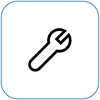What you see

Screen flickering is a noticeable fluctuation in the brightness levels of a screen. You might see rapid changes in light intensity, making the screen look like it's blinking or flashing. This might happen because of display settings, hardware issues, or even the refresh rate of the screen not syncing properly with the graphics card.
Note: If this isn't what you're seeing, you can find assistance with other display-related problems by visiting What to try if your Surface screen is flickering, distorted, or has other display issues.
What you can do
There are things you can do to troubleshoot your screen and try to get it working again.
Make sure the device is plugged into an appropriate power supply or Surface Dock to reduce issues that can occur when you're on battery power.
If the device has power, try refreshing the screen with keyboard shortcuts. Connect your Surface to a keyboard, then press the Windows logo key + Ctrl + Shift + B.
UEFI settings aren't in Windows, so display issues in UEFI suggest a problem with hardware, rather than with a Windows driver. Here's how to check if the screen issues only happen when you're using Windows:
-
Turn off your Surface and wait 10 seconds.
-
Press and hold the volume up button on your Surface, and at the same time, press and release the power button . The logo screen will appear.
-
Continue to hold the volume up button . Release the button when the UEFI screen appears.
-
View the screen and see if the problem is still present. If the screen is working correctly within UEFI, the problem is likely with the software installed on the Surface. Proceed with the reinstall the display adapter and OEM panel driver section.
You can try to force a shutdown and then restart. To do this:
-
Select Start > Power > Shut down , and wait a moment for your Surface to shut down. If you have any apps open, you may be prompted to close them prior to shut down.
-
Press and hold the power button for 20 seconds. If you see the logo screen appear after a few seconds, continue to hold for the full 20 seconds until you see the logo screen again.
See Force a shut down and restart your Surface for more info.
You can quickly check the health of your Surface drivers and firmware using the Surface app.
-
In the Surface app, expand Help & support to check the update status.
-
If there are updates available, select the Check for updates button to open Windows Update and install the available updates.
Note: If you don't have the Surface app installed, you can download the Surface app from the Microsoft Store. When it has downloaded, select Start, search for Surface, then select the app from the list of results.
Your Surface adjusts the screen brightness and contrast based on the content displayed. For example, if you open something that's mostly black, then you switch to something that's mostly white, the brightness and contrast may adapt. This is normal. This Content adaptive brightness and contrast feature provides optimal brightness and contrast levels, while saving power and providing longer battery life. You can adjust this option if you want it to behave differently—but if you do, your device won't run as long on battery power.
To temporarily disable this feature, just connect your Surface to the power supply. For more info, see Adaptive brightness and contrast on Surface devices.
Windows 11
-
Select Start , then select Settings > System > Display. Open Display settings
-
In Display settings, select Brightness, and then for Change brightness based on content, select Off.
Windows 10
To adjust the adaptive brightness and contrast behavior:
-
Select Battery on the Windows taskbar.
-
Move the slider to the Best performance setting.
Note: To maximize battery life, use the Recommended setting while on battery power.
Use these steps for Surface Go models, Surface Laptop 2 or newer, any Surface Laptop Go model, Surface Pro 6 or newer, Surface Book 3, or any Surface Laptop Studio model.
You'll need to confirm that your device has an Intel based processor to complete the following steps.
In the Surface app, expand Device information, select View More, and look at the value next to Processor.
For devices with an Intel processor
To adjust the graphic settings:
-
Open the Intel Graphics Command Center app, available from Microsoft Store.
-
Select System from the leftmost menu, then select Power from the upper-right menu.
-
First try sliding the Power Efficiency setting to the left to improve the graphics quality, while still saving some battery life.
-
After adjusting the Power Efficiency setting, if the graphics quality still needs improvement, move the Display Power Savings setting to Off.
-
Finally, if more improvements are necessary, move the Panel Self Refresh setting to Off.
Note: To maximize battery life, we recommend keeping the default settings.
Windows 11
Make sure you're optimizing Energy recommendations
-
Select Start > Settings > System > Power & battery > Energy recommendations.
-
Apply all settings changes that may be marked with an "!" requiring attention.
Adjust the Power Mode setting
-
Select Start > Settings > System > Power & battery .
-
Set the Power mode setting to Better performance or Best performance.
Windows 10
Try running our troubleshooter
The troubleshooter can automatically determine if you have the optimal power settings for your screen and it can adjust if needed.
-
Select Start > Settings > System > Troubleshoot. Open Troubleshoot settings
-
Select Other troubleshooters , and next to Power , select Run.
Adjust the Power Mode setting
Newer devices have an adjustable power mode that allows you to balance your preference between best battery life and best performance.
To view this setting, select the battery icon on the task bar. If your device supports it, move the Power Mode slider to the Better performance or the Best performance setting.
Some issues may occur when the device is powered on for extended periods of time—this includes time the device is in Sleep mode.
To resolve flickering and lines through your screen, try fully turning off the device. Closing the lid or toggling the power button only puts the device to sleep, which won't work. You'll need to fully turn off the device for at least 48 hours (the longer you can keep the device off, the more successful this method will be—this may work best if performed over a weekend, for example).
To shut down, select Start and then select Power > Shut down .
After the issue has been resolved, we encourage turning the device off (not just sleep) for at least one full night per week to prevent the issue from reoccurring.
Important: The following steps should not be performed on Windows Arm®-based Surface devices such as Surface Pro X, Surface Pro 9 with 5G, Surface Pro (11th Edition), or Surface Laptop (7th Edition). The only way to restore uninstalled drivers is by full system restore.
Some drivers may create display issues. To update your display driver and panel driver, you'll need to uninstall the current drivers and then check for driver updates.
Windows 11
-
Select and hold (or right-click) Start and select Device Manager.
-
Expand the Monitor section, select and hold (or right-click) the Surface panel driver(s), then select Uninstall device. Read the warning, then select Uninstall and restart your PC.
-
Expand the Display adapters section, select and hold (or right-click) the listed adapter (Intel and NVIDIA graphics drivers), then select Uninstall device. Confirm by selecting Attempt to remove the driver for this device, then select Uninstall and restart your PC.
-
After your PC restarts, select Start > Settings .
-
From Settings , select Windows Update > Check for updates, and install any available updates.Check for Windows updates
Windows 10
-
In the Search box on the task bar, type Device Manager, then select it in the results.
-
Expand the Monitor section, select and hold (or right-click) the Surface panel driver(s), then select Uninstall device. Read the warning, then select Uninstall and restart your PC.
-
Expand the Display adapters section, select and hold (or right-click) the listed adapter, then select Uninstall device. Read the warning, then select Uninstall and restart your PC.
-
After your PC restarts, select Start > Settings .
-
From Settings , select Update & Security > Windows Update > Check for updates , and install any available updates.
If you’re still having a problem with your display, try resetting your Surface. To learn how, see Restore or reset Surface for Windows and follow the recommended steps, or see create and use a USB recovery drive to reset your device to factory settings and drivers.
If you've reset your Surface and you are still experiencing a display issue, you'll need to submit a service order.
There's one last step you can take. If these steps don't resolve the problem, service and support options may be available to assist you.
Send to Microsoft To prepare your device for shipping to Microsoft, you can print a shipping label, check your Microsoft warranty, and create service orders.
Find in-person support In some countries, Microsoft now offers in-person service centers. Options may include professional hardware inspection, troubleshooting, and system recovery.
Self-repair If you're technically experienced and have the right tools, Microsoft has a select range of replaceable components and service guides that enable you to perform the repairs.
Note: If your Surface is a business device (owned by an organization), see Surface service options for Business and Education. Availability may be limited for some countries or products.
To learn more, go to How to get service or repair for Surface.
Related topics
What to try if your Surface touchscreen doesn't work
Adaptive brightness and contrast on Surface devices














